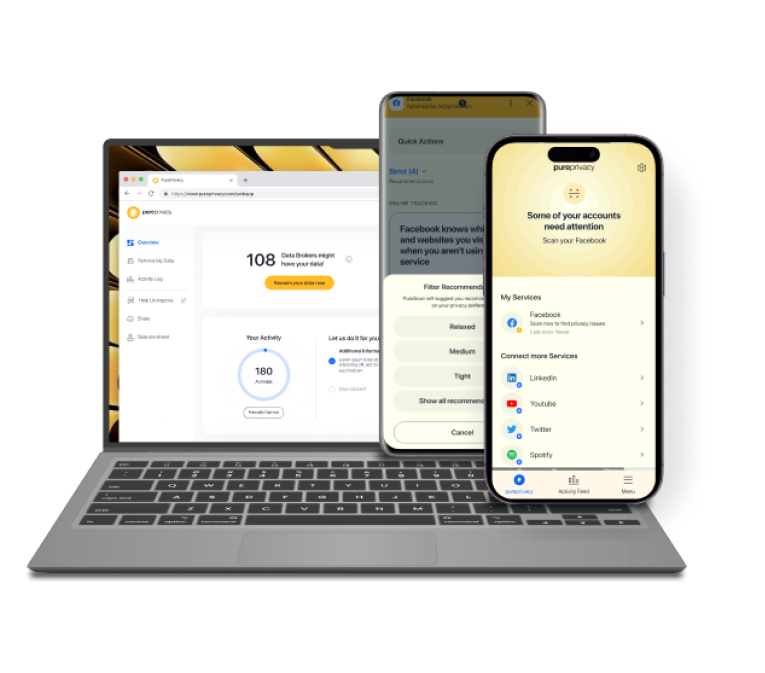Table of Content
Have you ever felt your private data is as open to theft as a home without locks?
Data breaches are happening more frequently, and protecting your personal information is as crucial as ever.
Research predicts that by 2025, the worldwide cost of cybercrime will have increased to $10.5 trillion from $9.5 trillion in 2024.
Wells Fargo has a lot of private information on its clients.
Let's explore some possible strategies to protect private data from online threats and data breaches.
Stay Away from Fraudsters and Scammers With PurePrivacy
PurePrivacy is an all-in-one privacy solution that helps you to protect your information from cyberthreats.
- Dark Web Monitoring: Scan the dark web for personally identifiable information.
- Tracker Blocker: Detects and removes third-party trackers that gather personal data.
- Remove My Data: Allow data removal from data brokers' databases.
- Social Privacy Manager: Gain complete control over your social media privacy settings.
How Does Wells Fargo Collect Your Data?
Like many other financial institutions, Wells Fargo gathers data about its clients to offer customized services and guarantee the security of their accounts.
This data is collected using various methods, such as in-person visits, online interactions, and third-party sources.

Types of Information Wells Fargo Gathers
The main ways that Wells Fargo gathers your information are as follows:
Account Details
The account details they collect include your name, address, phone number, and past financial transactions.
Online and Mobile Interactions
Wells Fargo gathers data on your online and mobile banking activities, including the pages you view and your purchases.
In-Person Interactions
Wells Fargo may gather personal data about you and your choices when you visit a branch or speak with customer care agents.
Third-Party Sources
Credit bureaus, fraud protection agencies, and other third parties may provide Wells Fargo with information about you.
Why is it Important to Understand Wells Fargo's Privacy Policy?
Knowing Wells Fargo's privacy policy is crucial for preserving your personal data, assisting with decision-making, and guaranteeing adherence to data privacy laws. It's important to understand Wells Fargo's privacy policy for several reasons:

Maintaining the Confidentiality of Personal Information
Understanding this information can help you better understand what data they have about you and how it is being protected.
Getting Knowledge of Data Sharing
The policy will specify which third parties, such as affiliates, service providers, or law enforcement, Wells Fargo may share your information with.
Recognizing Your Rights
The policy must specify your rights as a customer. Being aware of these rights enables you to manage your data more effectively.
Finding Possible Privacy Violations
If you know the policy and take the required action to protect your data, you can spot discrepancies or privacy violations more quickly.
Regulatory Compliance
Wells Fargo must abide by many data privacy laws. Knowing their privacy statement guarantees they comply with the law and defend your rights.
How to Protect Your Personal Information on Wells Fargo
According to these instructions, you can protect your Wells Fargo account and greatly lower the chance of unwanted access to your personal data. The following are crucial actions to take to protect your personal data on Wells Fargo:

Use Strong Passwords
Make sure your Wells Fargo account passwords are complicated and one-of-a-kind. Don't use information that can be guessed, such as pet names or birthdays.
Enable Two-Factor Authentication
Enabling two-factor authentication provides an additional degree of protection. Even if someone knows your password, you still need a code sent to your phone or email to access your account.
Consider Using a Secured Internet Connection
Use a secure internet connection (HTTPS) to access your Wells Fargo account. Avoid using open Wi-Fi networks for important activities.
Check Account Statements Frequently
Look for any fraudulent activity on your account statements. Report any suspicious activities right away.

Monitor the Dark Web
Get real-time dark web alerts to react quickly to security breaches, stop identity theft, and avoid financial damage.
Block Intrusive Trackers
Make your surfing experience anonymous and protect your privacy by blocking unwanted monitoring and advertising.
Protect Your Data from Doxxers
Reduce the threat that your information will be abused for illicit activities by removing your data from sneaky websites.
Scan Social Media Settings
Scan/rescan your social media privacy settings to rapidly evaluate and modify your privacy according to your requirements.
Frequently Asked Questions (FAQs)
-
How can I protect my Wells Fargo account?

Update your devices' browser versions, mobile apps, security updates, anti-virus, malware removal software, and plugins. After a certain amount of inactivity, Wells Fargo will automatically log you out of your online or mobile banking session.
-
Does Wells Fargo provide identity security?

If a consumer chooses to be protected, Wells Fargo Identity Theft Protection will monitor their personal information every day for indicators of identity theft.
-
How does Wells Fargo verify your identification?

They use Advanced Access to confirm your identity. They also help prevent unauthorized individuals from accessing your private data by requesting that you provide a code to be sent to your phone.
-
Why does Wells Fargo need me to provide identification?

Wells Fargo may ask for two-factor authentication when making online changes or transactions to verify your identity. By turning on Wells Fargo's 2FA function, or 2-Step Verification at Sign-On, users can improve the security of their accounts even more.
Wrapping Up!
Wells Fargo takes strong security steps to protect consumer data.
However, customers should exercise caution by avoiding phishing scams, creating secure passwords, and using PurePrivacy with VPN, which provides an extra degree of security by encrypting internet traffic and masking their online identities.





